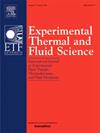Experimental study on fluid flow and mass transfer of non-Newtonian two-phase Taylor flow in a T-junction microchannel
IF 2.8
2区 工程技术
Q2 ENGINEERING, MECHANICAL
Experimental Thermal and Fluid Science
Pub Date : 2024-12-11
DOI:10.1016/j.expthermflusci.2024.111391
引用次数: 0
Abstract
The study systematically investigates the flow characteristics and mass transfer mechanism of liquid–liquid two-phase Taylor flow in microchannel. Deionized water with sodium hydroxide and silicone oil with acetic acid are used as the experimental media. Our findings reveal that symmetric slug flow exhibits the main internal circulation, while secondary circulation occurs in the head and tail as the length increases. However, due to the restriction of radial symmetry circulation, a significant amount of solute remains in the central axis. Moreover, the cap-like structure at the end of the slug flow hinders mass transfer between the liquid film and the continuous phase. We observe that the mass transfer coefficient of the entire channel decreases from about 0.03 1/s to 0.01 1/s with an increase in acetic acid concentration. Conversely, an increase in sodium hydroxide concentration decreases the mass transfer distance and time of the whole channel, thereby increasing the mass transfer coefficient throughout the microchannel. Furthermore, an increase in water viscosity results in a thicker liquid film around the oil phase, leading to secondary circulation and enhanced mass transfer between the liquid film and the main body of the oil phase, the mass transfer coefficient improved from approximately 0.01 1/s to 0.028 1/s. Additionally, changes in water surface tension significantly alter the liquid–liquid two-phase flow pattern in the microchannel at low flow velocities, consequently affecting the mass transfer process, the mass transfer coefficient can reach up to 0.045 1/s. We derive the equation for the mass transfer coefficient in microchannels under the shape of symmetric slug flow through theoretical analysis. Furthermore, we develop semi-empirical prediction models using data fitting methods for flow patterns of the mass transfer process, which are challenging to solve using theoretical models alone. By comparing the computational results with experimental data, we validated our model, achieving an accuracy within 30 %, successfully predicting the mass transfer coefficients under complex two-phase conditions.
求助全文
约1分钟内获得全文
求助全文
来源期刊

Experimental Thermal and Fluid Science
工程技术-工程:机械
CiteScore
6.70
自引率
3.10%
发文量
159
审稿时长
34 days
期刊介绍:
Experimental Thermal and Fluid Science provides a forum for research emphasizing experimental work that enhances fundamental understanding of heat transfer, thermodynamics, and fluid mechanics. In addition to the principal areas of research, the journal covers research results in related fields, including combined heat and mass transfer, flows with phase transition, micro- and nano-scale systems, multiphase flow, combustion, radiative transfer, porous media, cryogenics, turbulence, and novel experimental techniques.
 求助内容:
求助内容: 应助结果提醒方式:
应助结果提醒方式:


